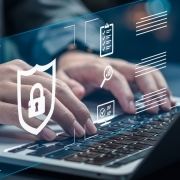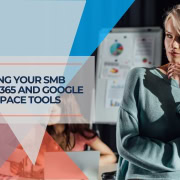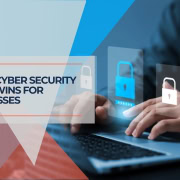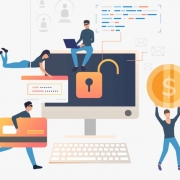Multi-Factor Authentication in 2025: Beyond Password Protection for Modern Businesses
Published: October 2024 | Last updated: September 2025
Key Takeaway: Multi-factor authentication (MFA) has evolved from an optional security measure to a business necessity in 2025. With 99.9% of compromised accounts lacking MFA protection and attackers developing sophisticated bypass techniques, businesses must implement phishing-resistant authentication methods like passkeys and FIDO2 while understanding that not all MFA solutions offer equal protection.
In 2025, business operations depend entirely on digital infrastructure. This dependence creates an expanding attack surface that cybercriminals exploit with increasing sophistication. While passwords remain the primary authentication method for 83% of organizations, they're also the weakest link—Microsoft reports over 1,000 password attacks per second against their systems alone. Multi-factor authentication (MFA) addresses this vulnerability, but as adoption grows, so do attacker techniques to bypass it. Understanding MFA's power and limitations is essential for building effective cybersecurity defenses in today's threat landscape.
Table of Contents
- 1 Understanding Multi-Factor Authentication in 2025
- 2 The 2025 Threat Landscape: Why MFA is Critical Now
- 3 Implementing MFA: A Practical Approach for Businesses
- 4 MFA Solutions for Businesses in 2025
- 5 Defending Against MFA Bypass Attacks
- 6 The Future of Authentication: What's Next
- 7 Frequently Asked Questions
- 7.0.1 What percentage of breaches could be prevented with MFA?
- 7.0.2 How do I protect against MFA fatigue attacks?
- 7.0.3 Should small businesses use the same MFA as enterprises?
- 7.0.4 What's the difference between passkeys and hardware security keys?
- 7.0.5 How much does implementing MFA actually cost?
- 7.0.6 Can MFA slow down our business operations?
- 8 Taking Action: Your MFA Implementation Roadmap
- 9 Additional Resources
Understanding Multi-Factor Authentication in 2025
What is MFA?
Multi-factor authentication requires users to provide multiple forms of evidence to verify their identity when accessing accounts or systems. Unlike single-factor authentication (typically just a password), MFA combines two or more independent credentials from different categories, making unauthorized access significantly more difficult even when passwords are compromised.
The Four Authentication Factors
- Something you know: Passwords, PINs, or security question answers. These remain the most common but also the most vulnerable authentication factor.
- Something you have: Physical devices like smartphones with authenticator apps, hardware security keys, or one-time codes sent via SMS. The security level varies significantly based on the specific method.
- Something you are: Biometric authentication, including fingerprints, facial recognition, voice patterns, or behavioral biometrics. These methods have become increasingly accurate and prevalent in 2025, with 66% of organizations now requiring biometrics for some resources.
- Somewhere you are: Location-based verification using GPS coordinates, IP addresses, or network detection. Modern systems combine this with behavioral analytics to detect anomalous access patterns.
Why MFA Effectiveness Varies
Not all MFA implementations provide equal security. Microsoft's research shows that accounts with MFA enabled are 99.9% less likely to be compromised—but this statistic applies primarily to phishing-resistant MFA methods. While better than passwords alone, traditional SMS-based MFA remains vulnerable to SIM-swapping attacks and interception. In 2025, 28% of users with MFA enabled still face successful attacks, primarily those using weaker MFA methods or falling victim to sophisticated bypass techniques.
The 2025 Threat Landscape: Why MFA is Critical Now
Current Adoption Rates Reveal Security Gaps
MFA adoption in 2025 shows a stark divide based on organization size. While 87% of enterprises with over 10,000 employees have implemented MFA, small businesses lag significantly behind:
- Large enterprises (10,000+ employees): 87% MFA adoption
- Mid-size companies (1,001-10,000 employees): 78% adoption
- Small businesses (26-100 employees): 34% adoption
- Very small businesses (1-25 employees): 27% adoption
This adoption gap leaves small and medium businesses particularly vulnerable. The technology industry leads with 87% MFA implementation, while other sectors lag behind, creating opportunities for attackers to target less-protected organizations.
Evolving Attack Methods in 2025
Cybercriminals have adapted their tactics to target MFA implementations directly. Understanding these threats is essential for choosing appropriate MFA solutions:
MFA Bypass Techniques Observed in 2025
- MFA Fatigue (Push Bombing): Attackers flood users with authentication requests until they approve one out of frustration or confusion. This technique exploits simple push notification systems.
- SIM-Jacking: Attackers take control of phone numbers to intercept SMS-based authentication codes, making telephony-based MFA increasingly risky.
- Adversary-in-the-Middle (AiTM) Attacks: Sophisticated phishing sites that capture both passwords and MFA tokens in real-time, then replay them to gain access before they expire.
- Session Token Theft: Attackers steal authenticated session cookies, bypassing MFA entirely by using already-verified sessions.
- Social Engineering: Attackers manipulate help desk staff or use deepfake technology to bypass MFA recovery processes.
These evolving threats underscore why organizations need phishing-resistant MFA methods rather than simply “any” MFA implementation.
The Passkey Revolution
Passkeys represent the most significant authentication advancement in 2025. Built on FIDO2 standards, passkeys eliminate passwords entirely while providing phishing-resistant authentication. Adoption has accelerated dramatically:
- Over 15 billion online accounts now support passkeys (doubled from 2024)
- Consumer awareness increased 50% since 2022, reaching 57% in 2024
- 61% of consumers believe passkeys are more secure than passwords
- 58% find passkeys more convenient than traditional authentication
- 25% of users who adopt one passkey enable them whenever possible
For businesses considering authentication modernization, implementing passkeys offers the strongest protection against current and emerging threats.
Implementing MFA: A Practical Approach for Businesses
Step 1: Assess Your Current Authentication Posture
Before implementing MFA, understand your current security landscape. Consider conducting a comprehensive security assessment to identify:
- Which accounts and systems contain sensitive data
- Current password policies and compliance
- Existing authentication methods in use
- User technical proficiency and potential adoption challenges
- Regulatory requirements (HIPAA, PCI-DSS, SOC 2, etc.)
Step 2: Choose the Right MFA Methods
MFA security exists on a spectrum. Here's how different methods rank in 2025:
MFA Method Security Ranking (Most to Least Secure)
1. Passkeys/FIDO2 Security Keys
Phishing-resistant, no shared secrets, cryptographically secure. The gold standard for 2025.
2. Hardware Security Keys (YubiKey, Titan)
Physical devices provide strong phishing resistance. Ideal for administrative accounts and high-value targets.
3. Authenticator Apps with Number Matching
Time-based codes (TOTP) or number-matching push notifications. Good balance of security and usability.
4. Biometric Authentication
Fingerprint, facial recognition, or voice. Secure when combined with device-based authentication.
5. Simple Push Notifications
Vulnerable to MFA fatigue attacks. Should be upgraded to number-matching or replaced entirely.
6. SMS/Voice Codes
Vulnerable to SIM-swapping and interception. Use only as a backup method or for low-risk accounts.
Step 3: Implement Strategically
Roll out MFA in phases to ensure smooth adoption:
- Phase 1 – Critical Accounts (Week 1-2): Enable MFA for email, administrative accounts, and financial systems. These provide the highest ROI for security investment.
- Phase 2—Business Systems (Week 3-4): Expand to CRM, project management, and other business-critical applications.
- Phase 3 – All Accounts (Week 5-8): Require MFA for all business accounts and systems.
- Phase 4 – Optimization (Ongoing): Monitor adoption, address user friction, and upgrade to stronger MFA methods over time.
Step 4: Address User Experience
The average employee manages 3-5 passwords for IT resources, with 15% juggling 10 or more. While 67% of IT professionals acknowledge that additional security measures create friction, modern MFA solutions minimize this through:
- Single Sign-On (SSO) Integration: Authenticate once to access multiple applications
- Adaptive Authentication: Adjust requirements based on risk level and context
- Passwordless Options: Eliminate passwords entirely using passkeys or biometrics
- Remember Device Features: Reduce authentication frequency for trusted devices
Combining MFA with a business password manager significantly improves both security and user experience.
MFA Solutions for Businesses in 2025
The MFA market reached $17.76 billion in 2025, driven by advances in biometric technology, cloud computing, and increased regulatory requirements. Here's how current solutions compare:
Free and Consumer-Focused Solutions
Microsoft Authenticator
Cost: Free
Best for: Microsoft 365 users, small businesses
Key features: TOTP codes, push notifications with number matching, passwordless sign-in for Microsoft accounts, biometric authentication support
2025 update: Microsoft discontinued password management features in August 2025, focusing the app entirely on authentication. Integrates seamlessly with Microsoft 365 and Azure AD.
Limitations: Primarily optimized for Microsoft ecosystem, limited enterprise management features
Google Authenticator
Cost: Free
Best for: Google Workspace users, personal use
Key features: TOTP code generation, cloud backup and sync (added 2023), simple interface
Strengths: Widely supported, simple to use, reliable
Limitations: No push notifications, limited business management features, basic functionality only
Authy
Cost: Free
Best for: Users who switch devices frequently
Key features: Multi-device sync, encrypted cloud backup, TOTP support
Strengths: Excellent for users with multiple devices, good backup options
Limitations: No enterprise features, owned by Twilio (consider vendor lock-in)
Enterprise MFA Platforms
Duo Security (Cisco)
Cost: Free (1-10 users), $3/user/month (Essentials), $6/user/month (Advantage), $9/user/month (Premier)
Best for: Small to large businesses needing comprehensive identity security
Key features:
- Phishing-resistant MFA with device proximity verification
- Complete passwordless authentication using Duo Mobile and FIDO2
- Device health checks and trusted endpoint verification
- Risk-based authentication with real-time adjustments
- Identity Threat Detection and Response (ITDR) in Premier tier
- Session theft protection
- AI assistant for access issue investigation (Premier)
Strengths: Excellent free tier for small businesses, comprehensive security features, strong device health capabilities
Considerations: Pricing scales with features; advanced capabilities require higher tiers
Okta Workforce Identity Cloud
Cost: Starting at $2/user/month (SSO only), $1,500 minimum annual contract
Best for: Mid-size to enterprise organizations with complex identity needs
Key features:
- Comprehensive single sign-on (SSO)
- Multi-factor authentication with multiple methods
- Universal Directory for centralized user management
- Lifecycle management automation
- API access management
- Extensive third-party integrations (7,000+ pre-built)
Strengths: Industry-leading integration ecosystem, flexible scaling, comprehensive identity management
Considerations: Complex pricing structure, annual contract minimum, additional costs for advanced features
Hardware Security Keys
YubiKey 5 Series
Cost: $45-70 per key (one-time purchase)
Best for: Administrative accounts, high-security requirements, compliance needs
Key features:
- FIDO2/WebAuthn, U2F, OTP, Smart Card support
- Works with thousands of services (Google, Microsoft, AWS, etc.)
- No batteries or network connectivity required
- Durable hardware designed for years of use
- FIPS 140-2 certified options available
ROI insight: Forrester research shows YubiKeys reduce phishing risk by 99.9% and cut password-related helpdesk tickets by 75%, with typical ROI achieved within 6 months for organizations with 500+ users.
Considerations: Requires physical possession, users need backup authentication methods, upfront hardware cost
Choosing the Right Solution
| Organization Size | Recommended Solution | Approximate Cost |
|---|---|---|
| 1-10 employees | Duo Free + Microsoft/Google Authenticator | $0/month |
| 11-50 employees | Duo Essentials or Advantage | $150-300/month |
| 51-500 employees | Duo Advantage/Premier or Okta | $300-4,500/month |
| 500+ employees | Okta or Duo Premier with ITDR | $4,500+/month |
| High-security accounts (any size) | YubiKey hardware keys | $45-70 per user (one-time) |
Defending Against MFA Bypass Attacks
As MFA adoption increases, attackers focus on bypass techniques. Protect your implementation with these strategies:
1. Implement Number Matching
Replace simple “approve/deny” push notifications with number matching, where users must enter a code displayed on their device. This prevents MFA fatigue attacks where users approve requests without verification.
2. Set MFA Request Limits
Configure systems to limit authentication attempts and lock accounts after suspicious activity. For example, block accounts after 5 failed MFA attempts within 15 minutes.
3. Eliminate SMS-Based MFA
Transition away from SMS and voice-based authentication for sensitive accounts. SIM-swapping attacks have become increasingly common and sophisticated in 2025.
4. Deploy Conditional Access Policies
Use risk-based authentication that considers:
- User location and typical access patterns
- Device health and compliance status
- Network security posture
- Time of access and behavioral anomalies
5. Monitor for Session Token Theft
Implement session theft protection that detects and blocks stolen authentication tokens. Modern solutions can identify when session cookies are used from unexpected locations or devices.
6. Train Users on Social Engineering
Educate employees about:
- MFA fatigue attacks and the importance of denying unexpected requests
- Phishing techniques that attempt to capture MFA codes
- Social engineering tactics targeting help desk staff
- The dangers of sharing authentication codes or approving requests without verification
The Future of Authentication: What's Next
Authentication technology continues evolving rapidly. Key trends shaping 2025 and beyond:
Passwordless Becomes Mainstream
With 15 billion accounts now supporting passkeys and adoption doubling annually, passwordless authentication is transitioning from emerging technology to standard practice. Major platforms including Apple, Google, Microsoft, and Amazon have fully embraced passkeys, making them accessible to billions of users.
AI-Driven Adaptive Authentication
Modern MFA systems use machine learning to analyze hundreds of signals in real-time, adjusting authentication requirements dynamically. This balances security with user experience by requiring stronger authentication only when risk indicators suggest potential threats.
Regulatory Mandates Accelerate
Government agencies and industry bodies increasingly mandate MFA for critical systems. Expect expanded requirements in healthcare (HIPAA), financial services (PCI-DSS), and government contractors (CMMC 2.0). Organizations should implement MFA proactively rather than reactively to compliance deadlines.
Biometric Authentication Maturity
With 66% of organizations now requiring biometrics for some resources, this authentication factor has matured significantly. Advances in liveness detection and anti-spoofing technology address earlier security concerns, making biometrics increasingly reliable for business use.
Identity Threat Detection and Response (ITDR)
The newest frontier in identity security, ITDR solutions actively monitor for identity-based threats and respond automatically. This proactive approach detects compromised credentials, suspicious access patterns, and privilege escalation attempts before they result in breaches.
Frequently Asked Questions
What percentage of breaches could be prevented with MFA?
Microsoft research indicates that 99.9% of compromised accounts did not have MFA enabled. However, this statistic applies primarily to phishing-resistant MFA methods. In 2025, 28% of users with MFA enabled still face successful attacks, typically those using weaker MFA methods (SMS) or falling victim to sophisticated bypass techniques. Implementing strong, phishing-resistant MFA like passkeys or hardware keys provides the highest protection.
How do I protect against MFA fatigue attacks?
MFA fatigue (push bombing) attacks can be prevented by: (1) implementing number matching instead of simple approve/deny notifications, (2) setting limits on authentication request frequency, (3) training users to deny unexpected requests and report suspicious activity, and (4) using risk-based authentication that flags unusual patterns. Modern MFA solutions like Duo and Okta include built-in protections against these attacks.
Should small businesses use the same MFA as enterprises?
Small businesses need strong MFA but can start with more accessible solutions. Duo offers a free tier for up to 10 users that provides enterprise-grade protection. As you grow, you can upgrade to paid tiers with additional features. The key is implementing phishing-resistant MFA appropriate to your risk level—even small businesses handling customer data or financial information should prioritize strong authentication over convenience.
What's the difference between passkeys and hardware security keys?
Both use FIDO2 standards for phishing-resistant authentication, but differ in implementation. Passkeys are stored in your device's secure enclave (phone, computer) or password manager and sync across devices. Hardware security keys like YubiKey are physical devices that must be present for authentication. Passkeys offer better convenience and user experience, while hardware keys provide maximum security for high-value accounts since they can't be remotely compromised.
How much does implementing MFA actually cost?
Costs vary significantly based on organization size and solution choice. Small businesses (1-10 employees) can implement strong MFA for free using Duo Free or Microsoft/Google Authenticator. Mid-size businesses (50-500 employees) typically spend $300-4,500/month on enterprise MFA platforms. Hardware security keys require upfront investment ($45-70 per user) but no ongoing costs. Forrester research shows that organizations typically achieve ROI within 6 months through reduced breach risk and lower helpdesk costs.
Can MFA slow down our business operations?
Modern MFA implementations minimize friction through single sign-on (SSO), adaptive authentication, and passwordless options. While 67% of IT professionals acknowledge that security measures add some complexity, properly implemented MFA actually improves productivity by reducing password reset requests (which account for 20-50% of helpdesk tickets) and enabling secure remote access. The key is choosing user-friendly methods and implementing gradually with proper training.
Taking Action: Your MFA Implementation Roadmap
Multi-factor authentication has evolved from optional security enhancement to business necessity. With 99.9% of compromised accounts lacking MFA protection and attackers developing increasingly sophisticated bypass techniques, the question isn't whether to implement MFA, but how to do it effectively.
Start by assessing your current authentication security through a comprehensive cybersecurity framework. Prioritize protecting your most critical accounts—email, administrative access, and financial systems—then expand coverage systematically. Choose phishing-resistant methods like passkeys or hardware keys for high-value accounts, and ensure your implementation includes protections against MFA bypass attacks.
The small business adoption gap (only 27-34% of small businesses use MFA) creates significant risk. If you haven't implemented MFA yet, start today with free solutions like Duo Free or Microsoft Authenticator. The cost of implementation is minimal compared to the potential impact of a breach, which averages $4.45 million according to IBM's 2023 Cost of a Data Breach Report.
Remember that MFA is one component of comprehensive security. Combine it with strong password policies managed through a business password manager, regular security training, and ongoing monitoring to build defense in depth against modern cyber threats.
Additional Resources
- CISA Multi-Factor Authentication Guide: https://www.cisa.gov/mfa
- FIDO Alliance Passkey Resources: https://fidoalliance.org/passkeys/
- NIST Digital Identity Guidelines (SP 800-63B): https://pages.nist.gov/800-63-3/
- Microsoft Identity Security Resources: https://www.microsoft.com/en-us/security/business/identity-access







Leave a Reply
Want to join the discussion?Feel free to contribute!